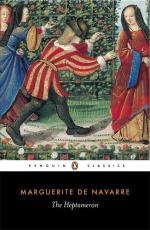It is, however, undoubtedly curious, and not to be explained merely by the difference of subject, that the styles of the letters and of the poems, agreeing well enough between themselves, differ most remarkably from that of the Heptameron. The two former are decidedly open to the charges of pedantry, artificiality, heaviness. There is a great surplusage of words and a seeming inability to get to the point. The Heptameron if not equal in narrative vigour and lightness to Boccaccio before and La Fontaine afterwards, is not in the least exposed to the charge of clumsiness of any kind, employs a simple, natural, and sufficiently picturesque vocabulary, avoids all verbiage and roundabout writing, and both in the narratives and in the connecting conversation displays a very considerable advance upon nearly all the writers of the time, except Rabelais, Marot, and Desperiers, in easy command of the vernacular. It is, therefore, not wonderful that there has, at different times (rather less of late years, but that is probably an accident), been a disposition if not to take away from Margaret all the credit of the book, at any rate to give a share of it to others. In so far as this share is attempted to be bestowed on ladies and gentlemen of her Court or family there is very little evidence for it; but in so far as the pen may be thought to have been sometimes held for her by the distinguished men of letters just referred to (there is no reason why Master Francis himself should not have sometimes guided it), and by others only less distinguished, there is considerable internal reason to favour the idea. At all times and in all places—in France perhaps more than anywhere else—kings and queens, lords and ladies, have found no difficulty (we need not use the harsh Voltairian-Carlylian phrase, and say in getting their literary work “buckwashed,” but) in getting it pointed and seasoned, trimmed and ornamented by professional men of letters. The form of the Heptameron lends itself more than any other to such assistance; and while I should imagine that the setting, with its strong colour, both of religiosity and amorousness, is almost wholly Margaret’s work, I should also think it so likely as to be nearly certain that in some at least of the tales the hands of the authors of the Cymbalum Mundi and the Adolescence Clementine, of Le Macon and Brodeau, may have worked at the devising, very likely re-shaped and adjusted by the Queen herself, of the actual stories as we have them now.




